Woven dry-grass mats across South Asia are an expression of common culture
Transcending narrow geographical borders, handicrafts often make their own presence felt as a representation of humanity, connecting communities. One such important handicraft item is the dry grass mats of the region of South Asia
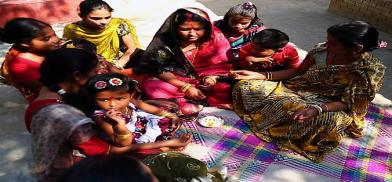
A noted civil servant from yesteryears, famous folklorist and writer Gurusaday Dutta, born in Sylhet, in what is now Bangladesh and known for his contribution towards the preservation of folk art and crafts from Bengal region, often collected many items of handicrafts from the region he was working in. These were preserved carefully and still survive as significant examples. About these artifacts, he once mentioned: “Popular art in this region is not a crude art of humble peasants but the expression by every individual…in a common national morphology, of a common ideology, inspiring the whole community. In this common culture, there was really nothing corresponding to a distinction between mass culture and class culture. The craftsmen and their patrons belonged not too different but to one and the same cultural stream.”
Transcending narrow geographical borders, handicrafts often make their own presence felt as a representation of humanity, connecting communities. One such important handicraft item is the dry grass mats of the region of South Asia. Connected through the basic concepts of warp and weft of weaving, the uniqueness and the variety amongst the mats, their usage, texture, patterns and symbolism, render each one to be a unique representation of a region and its ethos, including its geographical, social and cultural identities. Mostly woven during spring times to be used extensively during the mild to severe summers across the region of South Asia, these mats also often carry their interesting shares of folklore and narratives.
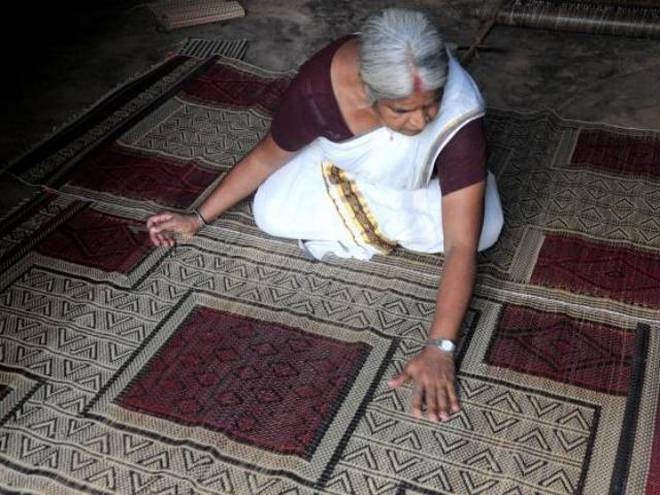
Indian traditions
In India, several states explore dry grass, cane and bamboo mats and many have a myriad history to explore. The bamboo sleeping mats of Meghalaya from amongst the Khasi and Jaintia regions are an excellent example of craftsmanship, including the woven chateau used often for screens of doors and windows in Tripura. The roll-mats are popular amongst locals as well as tourists in the region. The art of Shital Pati itself also elaborates across the Indian state of West Bengal- especially in the northern Cooch Behar district of West Bengal as well as in the neighbouring states of Tripura and Assam. A similar soft weaving comes from the kora/korai- river grass mats of the regions of Tamilnadu, Andhra Pradesh and Karnataka in India. Jute floor coverings are also popular in various southern parts of India (including Kerala), which are woven into many shades and weaves, like, Boucle, Panama, Herringbone, etc. These mats are made both through power-loom & handloom and in large volumes due to significant demand. Interesting to note is the art of the Pulppaya, a traditional grass-mat from Kerala, where the word pul in Malayalam means grass and pay a denotes mat and is made from the kora grass (sedge grass). The weaving is exclusively looked after by the Kuruva community. The process is an equal blend of indigenous material, craftsmanship and aesthetic sense and requires several stages of preparation before the canes can be prepared to weave the mat which is then polished and coloured with natural colours. The end result is a soft and cool material to sit upon even on hot summer days.
One of the oldest cottage crafts of Kerala is also the thazhapaya/screw pine mat of daily use woven by women. Especially coming from the Karunagapalli Taluk of Kollam district in Kerala, the plant grows on the banks of rivers and streams peeled into thin strips and dried and woven. They are often dyed and the quality of the mat is determined by the size of the strips and the closeness of the weave. Imparting a sense of relief in the summer is the wonderful Silk mat / Pattu paai / Pattamadai Pai (mat) from Tamilnadu in India. Renowned for the beautiful creations from the village of Pattamadai- a small town in Tamilnadu- the mat uses fine cotton or silk in the weft and is created by the local Labbai community. The predominant use of silk pattu or thread for weaving gives it the name Silk mat or pattu paai. The use of silk thread also gives a royal sheen and definite appeal to the mat and the primary colours vary between black, brown and red. Based on the weave, there are three different types of silk mats available in the market-coarse weave, medium and fine weave. Traditional motifs and natural dyes, over the years, have given way to contemporary motifs and synthetic dyes. An increase in demand has also seen the mat be mass-produced on power looms to meet domestic and international demands.
A decision taken at the 12th session of the meeting held at Jeju Island of the Republic of Korea, the Intergovernmental Committee of UNESCO on December 6, 2017 declared Bangladesh’s traditional art of Shital Pati mat of Sylhet to be inscribed on the representative list of Intangible Cultural Heritage (ICH) of Humanity. The inclusion of Shital Pati mats was the fourth element from Bangladesh which was inscribed in the UNESCO ICH list, the others being Mangal Shobhajatra on Pahela Baisakh (2016), the traditional art of Jaamdani weaving (2013) and Baul songs (2008).
Shital pati is woven from the cane slips from murta plants (Schumannianthus dichotomus) and these plants are known in different places as mostak, patipata, patibet and paitara. The murta plant grows around water bodies in Sylhet, Sunamganj, Barisal, Tangail, Comilla, Noakhali, Feni and Chittagong. The art of weaving shital pati portrays joining grass with grass and interlacing leaves to create a wonder that exudes glossiness and has a fine texture and imparts a sense of coolness to whoever sits on it. The aesthetic appeal and utilitarian value and ethnic touch have also made this mat available not only across rural areas but spread across several urban centres as well.
Across the Himalayan region of Nepal, one is often offered paddy-straw woven mats to sit upon. Especially created and woven by the womenfolk during the spring season, these gundri mats are created in the courtyards of houses by especially the womenfolk, though often nowadays the men are also seen to lend a helping hand. They are mostly made in the local agricultural months of Maagh and Phagun (January-March) by the women- from the straw (paraal) which is from the rice stalk harvested during November-December. It follows a simple and efficient technique as the strings obtained from a strong grass (babiyo) are tied between wooden poles, and the well-dried straw from the last harvest is woven through those strings into a dense fabric.
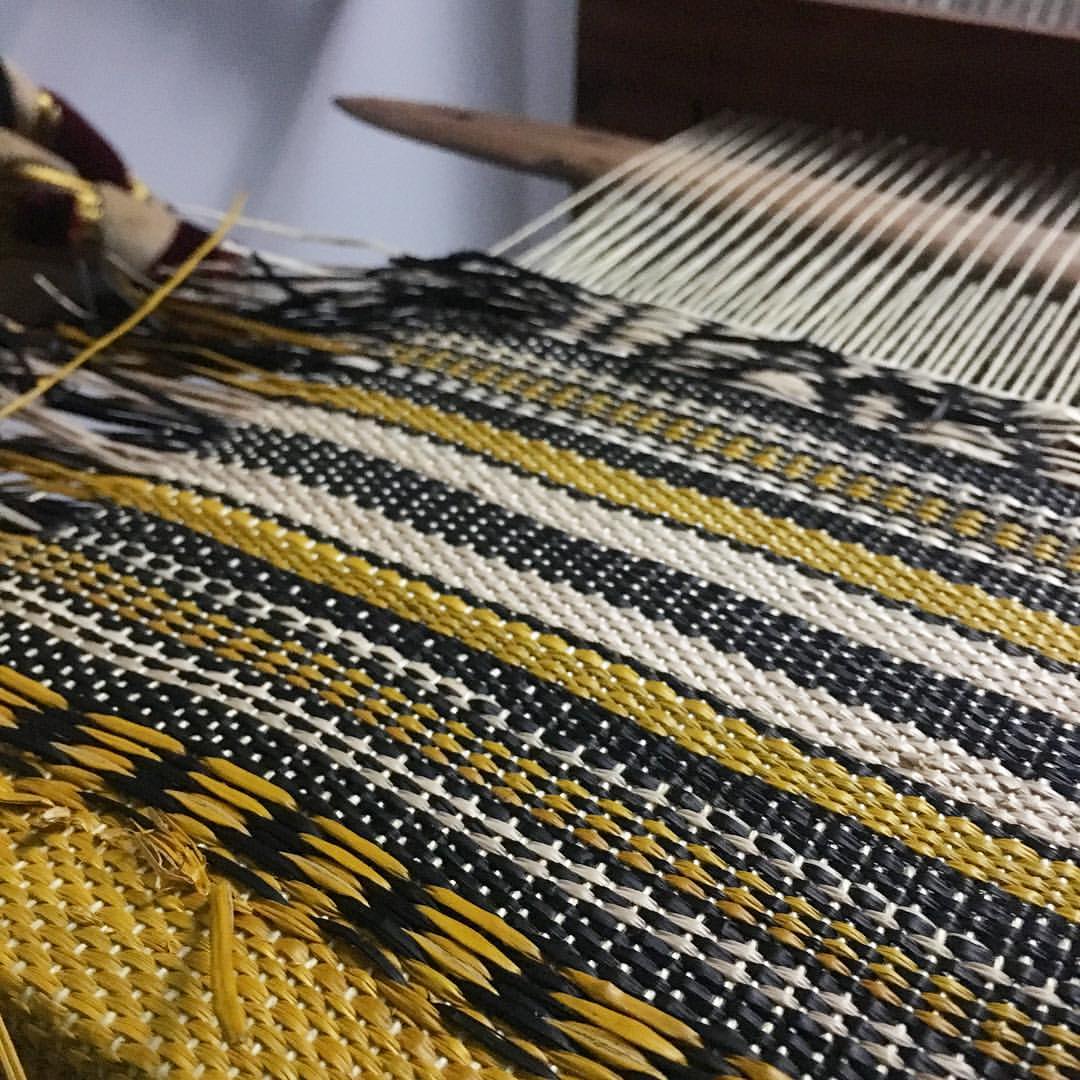
In Bhutan, Maldives and Sri Lanka
In the neighbouring mountainous region of Bhutan, bamboo carving and weaving are an important part of the local handicraft industry. The larger bamboos are an indispensable part of rural life and the smaller bamboo, found in central and western Bhutan is used for weaving mats, as fencing, or as roofing for temporary shelters. These split and woven mats are variously distributed all over the country and bamboo mat-weaving from Bumthang is popularly known.
Towards the southern parts, of Maldives, the fine patterns of the grass and reed mats are very popular. The fine pattern of the Thun’du Kunaa mats is often associated through many stories as a treasured item and as a royal gift from the past, they are often referred to as precious gifts for Dutch and British governors of Ceylon by the Sultans of Maldives. Traditionally woven by the womenfolk and especially famous from Huvadhoo. There are a few islands that make them and currently famous is the island of Gadhdhoo. Gadhdhoo does not harvest reed and gets it from the Fiyori island of Huvadhoo. It is still an important gift item and is woven with the aid of a simple loom and a knife which is used to slit the screw-pine leaves. The leaf, or hau, is collected and left to dry in the sun and then it is dyed with four natural colours- (natural), black, brown and yellow. The thinner mats are woven with simple knots and the thicker mats have more complex knots. Traditionally the best Gadhdhoo mats were used by the Maldivian Royal House in Malé. Such was the royal association of these mats that part of the annual tribute from the Huvadhoo Atoll Chief to the royal court, used to be in the form of Gadhdhoo mats. The saanthi mats (small square, pattern weaving) and sataa (large square pattern weaving) are made from screw pine (pandanas) leaf woven mostly at various places from all over the country- especially northern islands. Lamu Atoll has grass mats with slight patterns and is presented with dye grass and natural grass. There are other non-dye and non-patterned mats from Baa Atoll, etc.
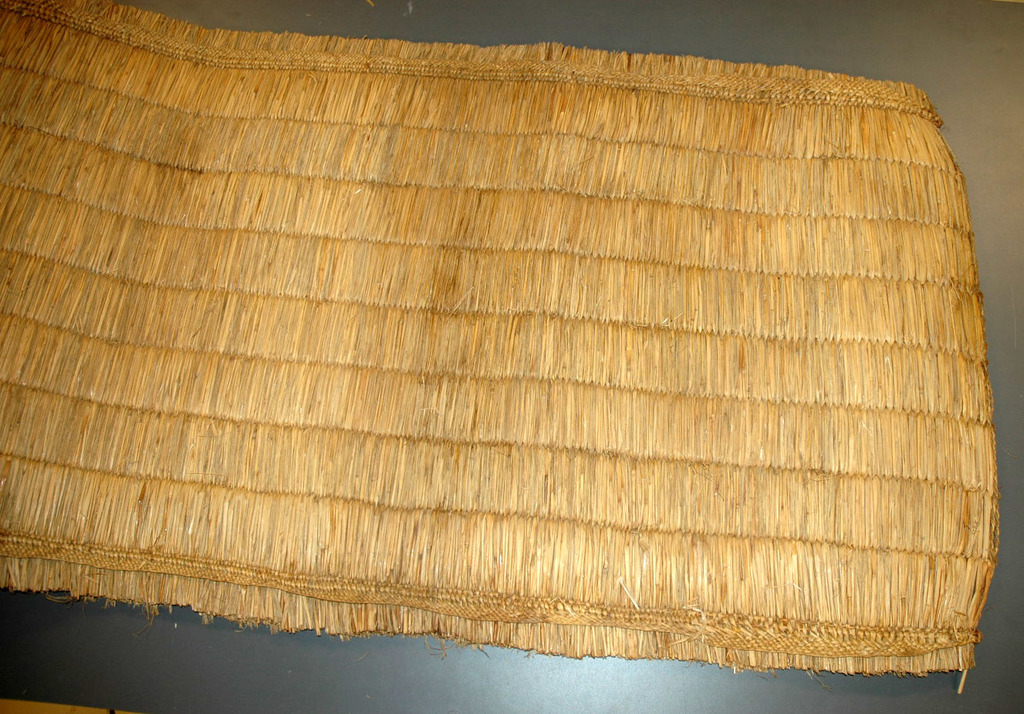
Nearby, in Sri Lanka, the slender reeds of the Havan Pan (Cyeres dehiscens), Gal Laha Pan (Cyperus corymbosus), Thun-hiriya (Eleocharis plantaginea), Gatapan (Scripus erectus), and Pothukola (Scleria oryzoides) – which are abundant on wetland river banks and in the marshes are harvested, cut into thin slivers and woven into intricate mats. Several natural dyes were used, a deep red was obtained by boiling patangi wood (Coesalpinia sappan) with korakaha leaves, gingelly oil and other herbs, black was obtained by boiling gall nuts (Cynips), aralu (Oroxylum indicum) and bulu (Terminalia belerica), and yellow was obtained by boiling veni-vel (Coscinium fenestratum). These were traditionally used as floor coverings, for sitting as well as sleeping. So famous are the pan-woven mats that an old poetic verse from Sri Lanka speaks of a royal appreciation of this humble piece of furniture. The verse narrates that Maha Sammatha Raja, the first mythological king of the world, appreciated the beautiful padura that was substituted for a mattress on his bed of the finest quality. The verse narrates how the minister of the king asked two women, a mother and her daughter-in-law, to weave a mat for the king. The mat they wove was so beautiful, the king was pleased and rewarded them with treasure the weight of an elephant. However, the mother-in-law took it all, leaving nothing for her son's wife. The two women warred through weaving, each trying to outdo the other by weaving mats with more and more intricate designs. Eventually, they made peace.
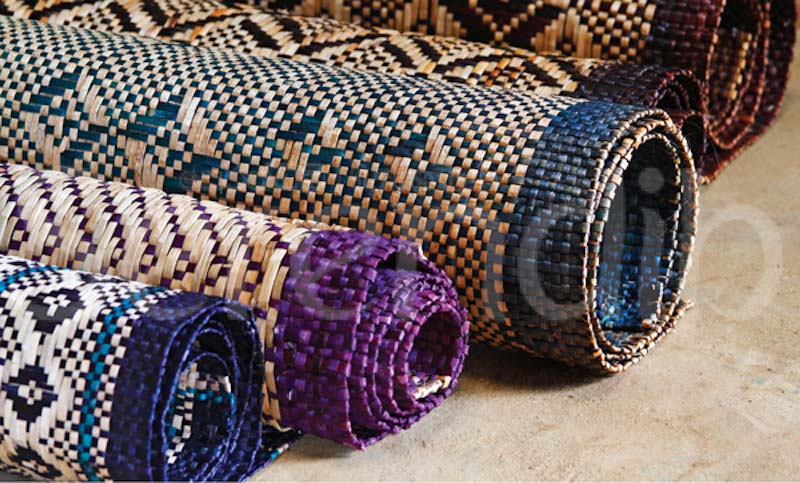
Generally having elaborate flower, tree and bird motifs, over time some of the intricate designs include- nelum (lotus), namal (Na flowers), hansaputtuwa (intertwined swans), wankagiriya (mountains), lanugetaya (rope), lanuwa (plait), the swastika and the mal gaha (flowering plant). Traditionally, woven by the womenfolk, the other form of ornamental and colourful Dumbara padura, used to be traditionally woven by both males and females on simple looms. The craft is practised in the Dumbara Valley in the suburbs of Kandy, especially in the village of Henawela. The yarn used in these mats is made from the leaves of Niyada (sansivera zeylanica) and more recently Hana (hemp). Some of these weaver families even claim to be descendants of Maha Sammatta Raja. In present times, pan-weaving is an important cottage industry.
In Afghanistan and Pakistan
Towards the northwestern parts, of Afghanistan, though the more famous and well-known stories revolve around the beautiful rugs and carpets, yet there are few examples of reed and dry grass mat-weavings. In areas of warm climate, like southern Afghanistan, the raw materials are perfect for this activity and produce widely for the local market.
In Pakistan, the rushes and kana reed with a core of soft pith grow in abundance along the banks of rivers and are often used to make prayer mats and runners. With both men and women helping in the process, the procedure involves a couple of split rushes used as a weft to cross the warp threads- first going under a certain number of warps and then going over equal numbers. The firm edges are woven by varying the number of warp threads in the two stages of crossing. The end result creates a thick and soft mat. Coiled rushes are used to create thick mats and coiled rushes are wound into modules which are then sewed together. The date palm fronds in rural areas are often used to make mats and the well-known chataai.
Date palm fronds are dried and dyed pink or black and woven into a chequered pattern. Entire summer shelters are also made from woven palm fronds by certain semi-nomadic groups in Balochistan, who also produce a great number of hand-twined palm-fiber ropes for use and sale. In Pakistan's Northwest Frontier Province and Balochistan using wild grass (mazri), also, wheat straw or types of palm leaf (pish) and willow is available for weaving. These woven mats are used for floorings as well as within layers of constructing earthen roofs and walls.
(The author is a visual anthropologist and author. The views expressed are personal. She can be reached at lopamudramaitra@gmail.com)
It is a little about myself: I live in Australia, my city
of Wakerley.
It's called often Easteen or cultural capital of QLD.
I've married 4 years ago.
I have 2 children -a son (Terrance) and the daughter (Elvis).
We aall like Yo-yoing.










Post a Comment